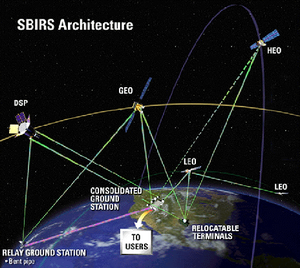

SBIRS system architecture with GEO, HEO, LEO satellites and ground stations (Credits: Lockheed Martin).
The U.S. Air Force is having problems communicating with Space Based Infrared System GEO-1 (SBIRS GEO-1), the first satellite of the next-generation of missile warning constellation in geostationary orbit. In the meantime, SBIRS GEO-2 is scheduled to be launched from Cape Canaveral on March 19.
“We had a very thorough examination of whether we were concerned about launching GEO-2 in light of the ongoing investigation on GEO-1,” said director of the Infrared Space Systems directorate at the Air Force Space and Missile Systems Center in Los Angeles, Col. James Planeaux. “The technical community came to the consensus that there’s no concern. So while we don’t rule out seeing the issues, we’ve made very good progress in understanding what’s going on and we’ll be able to address any of those issues with future software uploads to the vehicle or vehicles.”
According to Planeaux, the satellite’s performance had been “outstanding” until the first irregularity surfaced last year. The issue appeared intermittently at first, but then resurfaced frequently during the 2 months of trial testing, which began last November. The satellite was expected to complete the certification process and begin operations this year, but now the launch operators want to monitor GEO-2’s functionality before bringing GEO-1 into full operation.
SBIRS GEO-1, launched in May 2011, is part of a planned constellation of 4 geostationary satellites. The whole SBIRS system would have the capability to detect missile launches around the world. The entire system includes satellites in highly elliptical orbits, which are equipped with infrared sensors, as well as low Earth orbit satellites, and an extensive network of ground stations. There are currently 6 satellites of the SBIRS system orbiting, launched between 2006 and 2011. SBIRS is the replacement and upgrade of the Defense Support Program (DSP) constellation which has been providing missile warnings since the 70’s. The new spacecraft payload offers increased sensitivity, replacing the DSP scanning infrared telescopes. The sensors on these satellites can detect infrared emissions from intense sources of heat such as missiles, spacecraft launches, and nuclear explosions.
SBIRS GEO-1, as well asnthe soon-to-be-launched SBIRS GEO-2, is built by Lockheed Martin as prime contractor. According to Space News, the problem with GEO-1 is the latest of a series of delays and cost overruns afflicting this sensitive but very expensive program.
GEO-2, which was encapsulated on Atlas V’s payload fairing on March 14, is expected to be launched from Cape Canaveral on March 19. The spacecraft is expected to be certified in about 6 months. GEO-3 is scheduled to launch in 2015, with GEO-4 to follow in 2016. GEO-5 and GEO-6 will be contracted for production with Lockheed Martin later this year.

















































































































![A trajectory analysis that used a computational fluid dynamics approach to determine the likely position and velocity histories of the foam (Credits: NASA Ref [1] p61).](http://www.spacesafetymagazine.com/wp-content/uploads/2014/05/fluid-dynamics-trajectory-analysis-50x50.jpg)



Leave a Reply